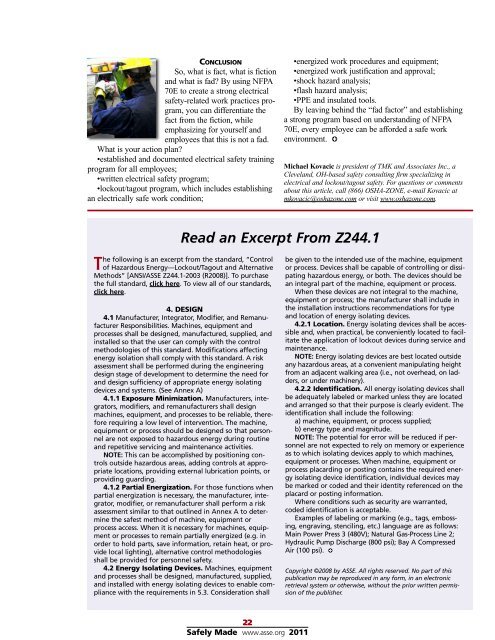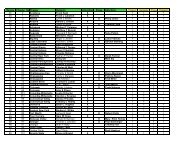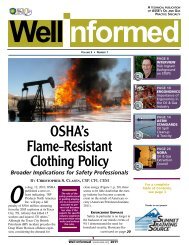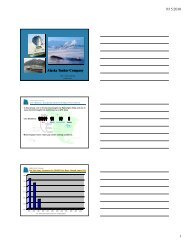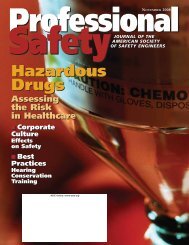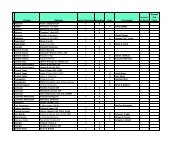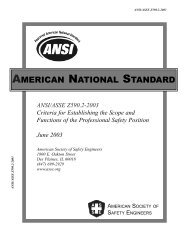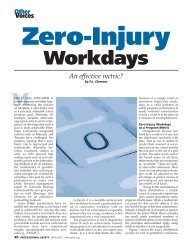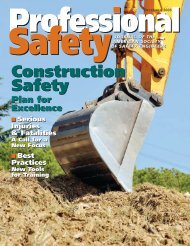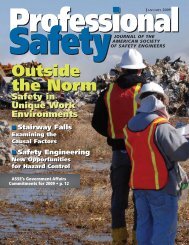Safety & Health Effects of Shift Work - ASSE Members
Safety & Health Effects of Shift Work - ASSE Members
Safety & Health Effects of Shift Work - ASSE Members
Create successful ePaper yourself
Turn your PDF publications into a flip-book with our unique Google optimized e-Paper software.
CONCLUSION<br />
So, what is fact, what is fiction<br />
and what is fad By using NFPA<br />
70E to create a strong electrical<br />
safety-related work practices program,<br />
you can differentiate the<br />
fact from the fiction, while<br />
emphasizing for yourself and<br />
employees that this is not a fad.<br />
What is your action plan<br />
•established and documented electrical safety training<br />
program for all employees;<br />
•written electrical safety program;<br />
•lockout/tagout program, which includes establishing<br />
an electrically safe work condition;<br />
•energized work procedures and equipment;<br />
•energized work justification and approval;<br />
•shock hazard analysis;<br />
•flash hazard analysis;<br />
•PPE and insulated tools.<br />
By leaving behind the “fad factor” and establishing<br />
a strong program based on understanding <strong>of</strong> NFPA<br />
70E, every employee can be afforded a safe work<br />
environment. <br />
Michael Kovacic is president <strong>of</strong> TMK and Associates Inc., a<br />
Cleveland, OH-based safety consulting firm specializing in<br />
electrical and lockout/tagout safety. For questions or comments<br />
about this article, call (866) OSHA-ZONE, e-mail Kovacic at<br />
mkovacic@oshazone.com or visit www.oshazone.com.<br />
Read an Excerpt From Z244.1<br />
The following is an excerpt from the standard, “Control<br />
<strong>of</strong> Hazardous Energy—Lockout/Tagout and Alternative<br />
Methods” [ANSI/<strong>ASSE</strong> Z244.1-2003 (R2008)]. To purchase<br />
the full standard, click here. To view all <strong>of</strong> our standards,<br />
click here.<br />
4. DESIGN<br />
4.1 Manufacturer, Integrator, Modifier, and Remanufacturer<br />
Responsibilities. Machines, equipment and<br />
processes shall be designed, manufactured, supplied, and<br />
installed so that the user can comply with the control<br />
methodologies <strong>of</strong> this standard. Modifications affecting<br />
energy isolation shall comply with this standard. A risk<br />
assessment shall be performed during the engineering<br />
design stage <strong>of</strong> development to determine the need for<br />
and design sufficiency <strong>of</strong> appropriate energy isolating<br />
devices and systems. (See Annex A)<br />
4.1.1 Exposure Minimization. Manufacturers, integrators,<br />
modifiers, and remanufacturers shall design<br />
machines, equipment, and processes to be reliable, therefore<br />
requiring a low level <strong>of</strong> intervention. The machine,<br />
equipment or process should be designed so that personnel<br />
are not exposed to hazardous energy during routine<br />
and repetitive servicing and maintenance activities.<br />
NOTE: This can be accomplished by positioning controls<br />
outside hazardous areas, adding controls at appropriate<br />
locations, providing external lubrication points, or<br />
providing guarding.<br />
4.1.2 Partial Energization. For those functions when<br />
partial energization is necessary, the manufacturer, integrator,<br />
modifier, or remanufacturer shall perform a risk<br />
assessment similar to that outlined in Annex A to determine<br />
the safest method <strong>of</strong> machine, equipment or<br />
process access. When it is necessary for machines, equipment<br />
or processes to remain partially energized (e.g. in<br />
order to hold parts, save information, retain heat, or provide<br />
local lighting), alternative control methodologies<br />
shall be provided for personnel safety.<br />
4.2 Energy Isolating Devices. Machines, equipment<br />
and processes shall be designed, manufactured, supplied,<br />
and installed with energy isolating devices to enable compliance<br />
with the requirements in 5.3. Consideration shall<br />
be given to the intended use <strong>of</strong> the machine, equipment<br />
or process. Devices shall be capable <strong>of</strong> controlling or dissipating<br />
hazardous energy, or both. The devices should be<br />
an integral part <strong>of</strong> the machine, equipment or process.<br />
When these devices are not integral to the machine,<br />
equipment or process; the manufacturer shall include in<br />
the installation instructions recommendations for type<br />
and location <strong>of</strong> energy isolating devices.<br />
4.2.1 Location. Energy isolating devices shall be accessible<br />
and, when practical, be conveniently located to facilitate<br />
the application <strong>of</strong> lockout devices during service and<br />
maintenance.<br />
NOTE: Energy isolating devices are best located outside<br />
any hazardous areas, at a convenient manipulating height<br />
from an adjacent walking area (i.e., not overhead, on ladders,<br />
or under machinery).<br />
4.2.2 Identification. All energy isolating devices shall<br />
be adequately labeled or marked unless they are located<br />
and arranged so that their purpose is clearly evident. The<br />
identification shall include the following:<br />
a) machine, equipment, or process supplied;<br />
b) energy type and magnitude.<br />
NOTE: The potential for error will be reduced if personnel<br />
are not expected to rely on memory or experience<br />
as to which isolating devices apply to which machines,<br />
equipment or processes. When machine, equipment or<br />
process placarding or posting contains the required energy<br />
isolating device identification, individual devices may<br />
be marked or coded and their identity referenced on the<br />
placard or posting information.<br />
Where conditions such as security are warranted,<br />
coded identification is acceptable.<br />
Examples <strong>of</strong> labeling or marking (e.g., tags, embossing,<br />
engraving, stenciling, etc.) language are as follows:<br />
Main Power Press 3 (480V); Natural Gas-Process Line 2;<br />
Hydraulic Pump Discharge (800 psi); Bay A Compressed<br />
Air (100 psi). <br />
Copyright ©2008 by <strong>ASSE</strong>. All rights reserved. No part <strong>of</strong> this<br />
publication may be reproduced in any form, in an electronic<br />
retrieval system or otherwise, without the prior written permission<br />
<strong>of</strong> the publisher.<br />
22<br />
Safely Made www.asse.org 2011


